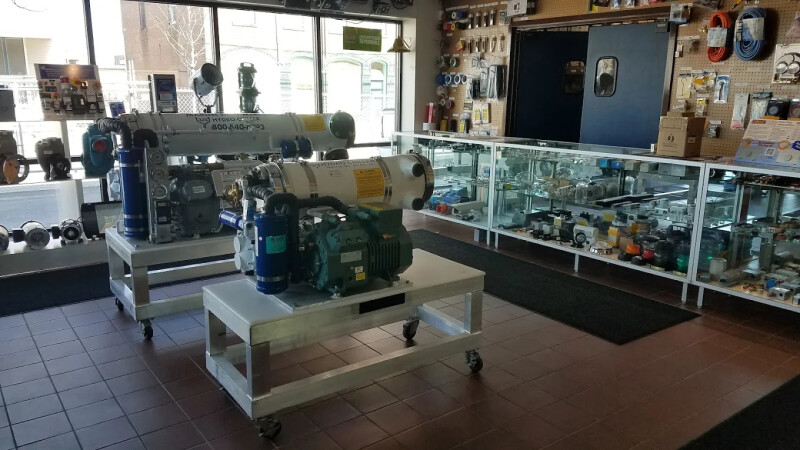From Gulf of Maine draggers to deep-sea pair trawlers, the push to modernize New England’s trawl gear has met a familiar wall: cost.
Paul Nosworthy, owner of New England Marine Engineering and Supply Inc., knows the numbers better than most.
“The back end of a midwater trawl — just the codend — costs around $40,000,” said Nosworthy. “Then you’ve got the sweep, the ground cables, the head section. All of that adds up. It’s not cheap gear.”
In a region where fuel efficiency is directly tied to profit margins, interest in lower-resistance nets, knotless twine, and semi-pelagic doors has grown, but Nosworthy said sticker shock still leads the conversation. “The technology has changed some,” he said, “There are new door designs depending on the fishery — midwater and otter trawls — but if you want to talk about what really works and what doesn’t, we’d need to ask the net-making companies.”
For now, fishermen are hesitant to gamble on new gear without proof that it will pay off. That hesitation, said Nosworthy, is rooted in survival. “It’s all about the cost. Gear on the bottom has a short life and a high cost to build and maintain,” he said. “And regulations are always changing — mesh sizes, chafing gear limits, you name it. Guys are less willing to try new stuff when the rules could change next year.”
He’s not wrong. In 2023 to 2024, five researchers with deep roots in the U.S. commercial fishing industry joined forces through the Fishery Friendly Climate Action Campaign to establish an evidence-based framework for fishing industry-led advocacy aimed at fostering a transition to a low-carbon fishing fleet. They evaluated emissions-reduction programs like the EPA’s Diesel Emissions Reduction Act (DERA) and California’s Carl Moyer Program, which underscore the high financial bar for commercial fishermen. According to the DERA report, the average cost of upgrading even a single engine on a fishing vessel is tens of thousands of dollars. While grants have made a difference, they haven’t erased the problem. Though these programs offer opportunities for some commercial fishermen, the programs and grants mainly focus on reducing air pollution, but do not cover all the technology and equipment that could lead to a low carbon fishing fleet.
One Maine fisherman who used the state’s Clean Diesel Program — a DERA-funded initiative — to replace a 1982 Caterpillar engine with a Tier-3 Mitsubishi engine summed it up, “Everybody makes out on the boat when we burn less fuel. To tell you the truth, my main motivation was not sending money to the fuel companies.”
Another recipient from Connecticut added, “We’re appreciative that the program exists,” after using funds to repower two dredge and trawl vessels.
But not all businesses and all types of projects meet these grants’ qualifying criteria. Nosworthy pointed out that while programs like DERA and the Rural Energy for America Program (REAP) are intended to support upgrades, not all clients are eligible or even aware. “I’m not an authority on this,” he said, “but what I see is they want less gear in the water.” However, trawl gear investments are not eligible for DERA or REAP, so fishermen interested in reducing fuel costs using this method must foot the entire bill themselves, which can be prohibitive for many businesses.
According to the DERA report, success often hinges on knowing that the program exists and meeting your region's or state's requirements for the programs or grants. One Rhode Island lobsterman explained that he applied after hearing about it from a friend. Another credited a bulk email from the state’s environmental department.
Nosworthy says it’s tough to plan for long-term change when short-term needs take priority. His shop stocks what sells — gear that gets boats back in the water fast. “We’re unable to keep in-stock items that won’t move quickly,” he explained. “We also have to pay a tax on all inventory. To pay a tax on equipment that isn’t selling is a financial hardship.”
That financial caution isn’t limited to gear. Fishermen across the country face similar choices when upgrading engines under programs like California’s Carl Moyer. A crab and salmon fisherman from the Bay Area replaces a pre-tier Detroit engine with a Tier 3 Cummins engine, using Carl Moyer funds that covered 85% of the total cost. Even so, he had to dip into his retirement savings to cover the rest.
“Even with the grant support, people are financing these projects by taking out lines of credit or selling personal assets,” according to the report. “One fisherman used profits from a strong Alaskan season. Another sold a residential property.”
That kind of financial risk is exactly why Nosworthy is cautious when it comes to pushing newer technologies, especially those that haven’t been proven on his customers’ vessels. “We stock what we know works,” he said. “We’re not in the position to gamble on gear that might sit in the warehouse for months.”
And he’s not alone in that thinking. The Carl Moyer report highlights that some air districts in California don’t prioritize marine applications at all, and even in districts that do, the programs often favor projects located in urban areas, where pollution impacts are more visible, rather than offshore vessels, which operate out of sight of the population centers that drive policy priorities.
There is also the issue of follow-through. Some grants require reporting engine hours in specific air districts for up to a decade, a requirement that’s hard to meet in fisheries with fluctuating stocks. One West Coast fisherman noted, “Hours is such a weird way to put things, because different fisheries are going to use different amounts of time on the water. You could be a better fisherman and more efficient, and still not qualify.”
Asked whether his business would be more inclined to promote newer gear if pilot programs or additional funding were available, he was candid. “Maybe. But it would have to make financial sense. You can’t stock gear that sits. We’re running a business, and that means moving inventory and helping our customers get back out fishing.”
Nosworthy summed it up plainly: “If you want fishermen to use new gear, you’ve got to make it worth it.
Find more on Talking Shop on a Low Carbon Fleet here.







